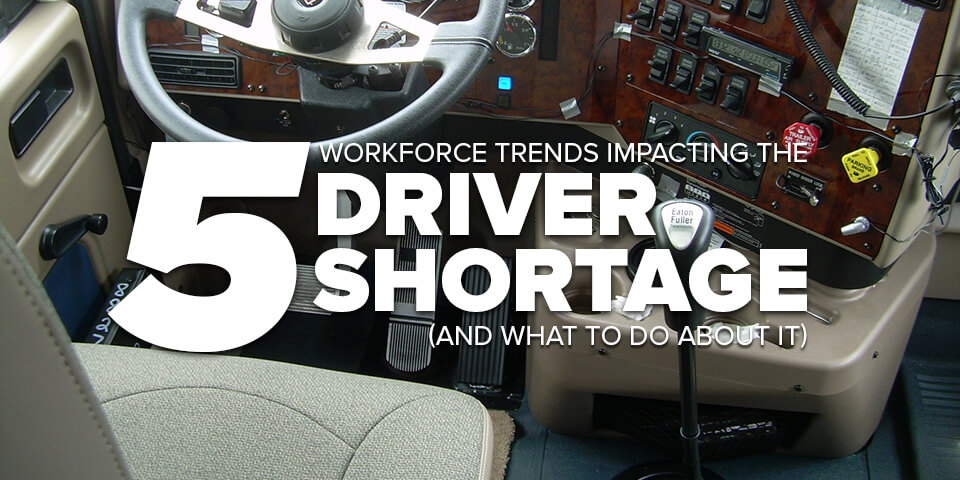In The News

5 Workforce Trends Impacting the Driver Shortage (and What to Do About It)
The driver shortage is the most critical issue in the trucking industry, with driver retention taking the third spot, according to the American Trucking Research Institute's (ATRI) most recent survey.
Tim Hindes, CEO at Stay Metrics, cited this study during his talk on “Driver Retention: Engage, Reward, and Keep Your Best Driver” at Expedite Expo 2019 in Ft. Wayne, Indiana, in July.
“[ATRI] asks every year: ‘What’s keeping you up at night? What are the most critical things you’re worried about?’ Truck owners in the U.S. say that driver shortage and driver retention are front and center on everybody’s mind,” says Hindes.
According to research by Stay Metrics, 60% of drivers leave within the first year, costing companies over $10,000 per driver. “That’s a lot of waste,” says Hindes.
What’s causing the driver shortage and turnover issues? Hindes points to five workforce trends.
Trend #1: The industry is failing to attract young workers—and paying the price for it.
A significant barrier to getting younger workers into the industry has been the federal rule that requires commercial vehicle drivers to be at least 21 years old.
“So, during the time that people are thinking about their career—when they’re 18, 19, 20—you can’t get them,” says Hindes.
But the industry is also impacted by an overall labor force participation rate for ages 16 to 24 that's trending down, which has increased competition for a shrinking pool of potential young drivers.
In fact, according to research by Timothy Judge, Ph.D., chief science officer of Stay Metrics, drivers under age 35 went from the largest group in 1994 to the smallest group in 2013—39.6% to 20.5%.
“There used to be buyouts for older workers. Now it’s, ‘Hey, can you stay one more year?’” says Hindes. “We’re asking people to stay in the market longer.”
Trend #2: Prospective hires have more alternatives in the trades.
“When I graduated from high school in 1984, only 56% of students went to college. So, the rest of them went into the labor force,” says Hindes.
He says that today, 70% of students are going to college, putting the squeeze on the number of available young workers.
This means that the trades—such as diesel engine mechanics, heating and air technicians, plumbers, electricians, and utility workers—are also experiencing a worker shortage.
So, for high school graduates not planning to attend college, “they have a hell of a lot better choices than getting into a truck,” says Hindes.
Trend #3: Fear of automation is discouraging career-minded people.
It could be several years, even decades, before self-driving trucks become a major force in the industry. But the hype around how autonomous vehicles will kill trucking jobs is hurting the industry’s recruitment efforts.
“We’re at the starting point when it comes to self-driving vehicles; it’s a ways out,” says Hindes. “But we’re freaking people out in terms of entering the industry.”
Trend #4: Automation is coming too slowly to offset the driver shortage.
“Our read is that [vehicle] automation is going to come too slow,” says Hindes.
So, what does that mean for trucking companies?
Don’t wait for automation to solve the driver shortage issue. Figure out how you’re going to compete for drivers—and keep them.
Trend #5. If you’re not laser-focused on retention, you’re dead.
Hindes posed the question: “Why do drivers leave?”
The answer: “Because they can.”
“[Drivers] have choices. They’re just leaving because there is no fear,” says Hindes.
What’s the solution?
Hindes says that trucking companies need to bridge, what he calls, “the Empathy Gap.”
He shared a story about a driver survey based on this question: “On a scale of 1-10, how much do you agree with the statement: ‘People should feel lucky to have a job.’ Strongly disagree (1) to strongly agree (10).”
Here’s how the numbers panned out:
- Depression-era people: 10
- Boomers: 8-9
- Millennials: 3
- Drivers: 1
Which demographic is managing the majority of the trucking companies in the U.S.?
The boomers, says Hindes.
So, when you compare the boomers in management (at 8 to 9 on the scale) to drivers (at 1)—that difference is the empathy gap.
But how do you bridge that gap?
In his classic bestseller, “The 7 Habits of Highly Effective People,” Steven Covey provides the answer with his Habit Number 5: “Seek first to understand, then to be understood.”
That’s because it’s easy for the boomer manager (or fleet owner) to say, “I just don’t get these drivers!” and continue with a rant.
But if you’re going to keep all your trucks rolling, you need to be willing to understand where drivers are coming from because they have options, says Hindes.
Consider looking at things from your driver’s perspective. How would you want to be treated so that you would be happy with the job and want to stay with the company?
“When I was [sharing the survey results] to a carrier who has 100 company trucks—with about 20 sitting in the yard—they were telling me how disgusted they were at these new drivers. And then I got to the millennials and the drivers [on the survey], and the 55-year-old guy stands up and says, ‘Those people repulse me!’” says Hindes.
“I’m like, ‘Dude. Order the coffin. You’re dead.’”
